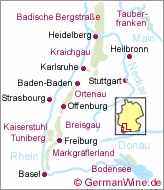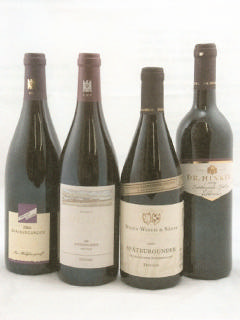Spätburgunder
The Rhine Valley in southwestern Germany is the home to the wine-producing region of Kaiserstuhl/
Baden. Since Roman times, this has been an ideal area for cultivating wine grapes. The soil consists of
magma from the depths of the earth and limestone from the former capping rock. The Kaiserstuhl is
Germany’s warmest region and has the most hours of sunshine. The area averages about a degree
higher in temperature than Burgundy to the south. This is prime growing territory for the Burgunder
or Pinot family of grapes: the Blauer Spätburgunder (Pinot Noir), the Weissburgunder (Pinot Blanc),
and the Grauburgunder (Pinot Gris).

Spätburgunder is also grown in the Ortenau district of Baden, in a separate, smaller wine-growing
region of Ahr located along steep hillsides that line the Ahr River as it flows into the Rhine, Franken,
Hessische Bergstrasse, Mitteirhein, Nahe, Pfalz, Rheingau, Rheinhassen, Sachsen, and Württemberg.
Many of these areas are better known for Riesling. Approximately 2300 acres of the Burgunder family
of grapes grow in the Kaiserstuhl region. 23% of the vineyards in Baden are planted to
Spätburgunder.
With the 2000 vintage, Germany has instituted the designations “Classic” and “Selection.” This
change was intended to simplify matters for consumers. Classic wines can be from any of the 13
German winegrowing regions, the wines must be above average in quality, dry in taste, and made
from a traditional grape variety, such as Riesling or a Burgunder. The labels bear the Classic logo next
to the name of the traditional grape variety. Vineyard names are omitted to leave the labels
uncluttered and simple for the consumer. Selection wines are carefully chosen, best of the vintage
wines. The vineyards are first-class, yields are low, harvesting is by hand, the wines must be bottle
aged, and the wines must be dry for Burgunder varietals.
Some terminology in deciphering labels can be helpful. Estate-bottled = gutsavfüllung or
erzeugerabfüllung, trocken = dry, and halbtrocken = half-dry (superfluous if wines are Classic and
Selection designated as all of them are dry in style).
German clonal selections are divided into five groups: compact clones, loose-berried clones, mixed
clones, upright-growing clones, and small-berried clones. In Germany, the strength of a clone in
resisting botrytis is uppermost in the selection process. The compact clones include the French Dijon
clones such as 113, 114, 115, 667, 777, 927, 792, 872, 870, and 386, all of which have some resistance to
botrytis. They are usually planted on dry, flat sites. The loose-berried clones are more resistant to
botrytis, even in heavy rain years. However, in most years, the quality of the compact clones
outweighs the advantage of better botrytis-resistance of the loose-berried clones. This group includes the Mariafeld clones from Wädenswil. The upright-growing clones are used for sparkling wine and
Pinot Noir vinified as a white wine. The small-berried clones come from Freiburg and Geisenheim and
are well-suited for producing high-value red wines. Due to good botrytis resistance, these clones can
be planted in deep and rich soils. Because there is high demand in Germany for these clones, they are
in limited supply.
The bible on German wines is The Gault Millau WeinGuide Deutschland. It is only published in
German and not available in the United States. This is a shame since it offers over 400 of the best
producers and nearly 4,000 reviews and ratings for wines.
There is only a trickle of information available about German Pinot Noir and very little of the best
examples reach the United States. I have had a few here and there, and not been impressed. I have
heard people joke, “Isn’t Spätburgunder the stuff the guys from Burgundy spat out?” All of this may
change as American’s thirst for Pinot Noir continues to escalate. Bjoern Lanwer, a German expatriot,
has recently co-founded Ingenium Wines with his American wife and a partner in Germany. While in
college, he met a schoolmate and friend whose father was a government official in the Kaiserstuhl
region, and he has been able to utilize his business degree and this contact to import German Pinot
Noir to America. Headquartered in Alabama, he plans to focus on good, rather than entry-level
Spätburgunder. Only recently arriving in the United States, he was surprised to find how “big” Pinot
Noir was here, and how interested Americans are in German wines. He sent me three Oberbergen
Pinot Noirs and one Pinot Gris to sample. The other importer I contacted was Truly Fine Wines Inc. in
San Diego, California. They also import limited production German wines inluding Rieslings, Pinot
Noirs, and rare dessert wines. I also sampled four of the Spätburgunders they are featuring.
Oberbergen
WG Oberbergen was founded in 1924 and is named after the village in which it is located.
Oberbergen is a few miles east of Burkheim in the Kaiserstuhl region. It has produced Pinot Noir for
over 60 years. Oberbergen wines are served in top hotels throughout Germany. I could not obtain
many specifics regarding the vineyards and winemaking. The Oberbergen Pinot Noir vines grow on
the steepest hillsides of the Kaiserstuhl. The main clone is FR-5286 which is a compact clone. German
oak is used for aging. For the Estate Pinot Noir, “a quick fermentation is performed in which the must
is heated for a short time, then cooled and pressed.” For the Select and Reserve Pinot Noirs, “a cold
maceration is carried out in closed, temperature controlled tanks and the fermentation days.” The wines are aged 4 to 6 months in oak barrels (little or no aging for the Estate).
2005 Oberbergen Pinot Noir Estate
(Note: the wines are labelled
Pinot Noir, not Spätburgunder) 13.0% alc., $19.
·
Attractive nose with
cherry, herbs and a hint of toast. Light in color and style, there still are
satisfying raspberry, strawberry and currant flavors with a strawberry
kiss at the end. Well-balanced and a pleasant drink,
2005 Oberbergen Pinot Noir Select
13.0% alc., $24
·
A small step up
in color. The aromatic profile is similar with n added touch of alcohol.
A soft and simple drink, with demure strawberry and oak flavors and a
finish with herbal highlights.
2005 Oberbergen Pinot Noir Reserve
12.5% alc., $32
·
Darker still in
color, this wine has similar aromatics, but there is a richer mouth feel
with more intense fruit, noticeable oak and a trace of tannin. Less
strawberry and more earth and sauvage. The finish is a tad shallow and
not as pleasing as the Estate.
2005 Oberbergen Pinot Gris
12.0% alc., $19.
·
This wine is very Alsatian
in style with interesting butterscotch aromas, midpalate fruit richness and
viscosity, and bright acid at the end. There is a trace of fuel oil in the
finish, typical of many Alsatian interpretations of this varietal. Perfectly
fine.
The Pinot Noirs are rather simple but they are well made with no flaws, soft textures, and a good acid
backbone. The flavors vere toward the red end of the spectrum. They are comparable to many
California Pinot Noirs in the under $20 category, but do not have enough fruit for many West Coast
palates. Ingenium Wines, www.ingeniumwines.com, 256-883-2011.
Truly Fine Wine, Inc.
2004 Gutzler Spätburgunder
14.5% alc., trocken, $24. The Gutzler estate is a boutique producer in
Rheinhessen.
·
This is a very California-styled Pinot Noir. The nose is rich with ripe stone fruits and a hint
of alcohol. The dark red fruits are mouth-coating and the wine has a creamy texture. The flavor profile is
rather simple, but this is a decent drink. The best wine in the Truly Fine Wine lineup.
2004 Hans Lang Spätburgunder
13.5% alc., trocken, $23. Hans Lang has been making Pinot Noir for
over 20 years. He is a pioneer of aging in barrique barrels. The grapes are from Rheingau.
·
This Pinot
Noir has a respectable nose of cherries and cranberries. It is a very light and soft style with bitter wood
flavors that persist in the finish.
2004 Julius Wasem & Söhne Spätburgunder
13.5% alc., trocken, $25.
·
The flavors trump the nose
here. Aromas of fermenting berries, citrus and grass lead to very light but attractive strawberry and
blackberry flavors with prominent herbal overtones. The texture is smooth and the ending quite soft. The
grassiness in the nose is reminiscent of Sauvignon Blanc.
2005 Dr. Hinkel Spätburgunder Spätlese
12.0% alc., halbtrocken, $20.
·
The unusual aromatics feature
port-like ripe fruits and green leaves. Light in weight, the wine is simple with sweet berries in abundance,
a touch of sweetness in the finish, and a little grassiness as well.

imports a wide variety of German
wines. The website is
www.trulyfinewine.com. These are
wines for the adventurous who seeks variety. They are really
better table wines than stand-up wines.